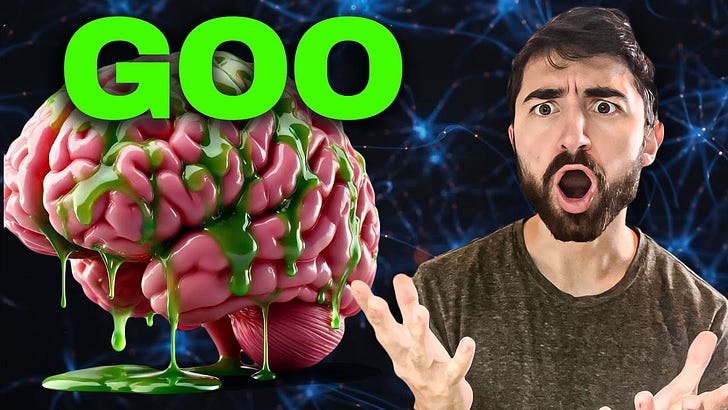Is Brain Goo Making you Fat?
New data in published Nature reveals how "Goo" in the brain traps insulin and contributes to metabolic dysfunction and obesity.
Could a newly discovered Goo in your brain be contributing to obesity?
It’s a scary thought, but also kind of a hopeful one, for in advancing our understanding of physiology we can innovate new approaches to solve the problems that plague us as individuals and a society, namely obesity.
In this letter, I’m going to walk you through new findings on “Brain Goo,” starting at a high level and then delving into the details, before providing you with solutions to make sure your brain is Goo-free and Happy!
At a high level this paper, published in Nature, finds that brain inflammation from a high-sugar, high-fat diet leads to thickening of a matrix (“Goo”) around a center in the brain that controls hunger and energy regulation.
This matrix then prevents insulin from signaling to the brain, leading to insulin resistance and – consequently – increased appetite, decreased energy expenditure, and fat gain and obesity.
Now, I want to show you the data.
Of note, these data were collected in mice… since you can’t chop off human heads for research studies. However, these data are consistent with the broader literature on neuroinflammation in humans, and with every reason to think they would generalize to other mammals.
With that, what you’re looking at below is a stain (white) for something called the peri-neuronal net (PNN), which is effectively the “Goo.” Technically, the PNN is a specialized form of extracellular matrix, a network of proteins and scaffolding surrounding cells. This PNN “Goo” is here found in a region of the brain called the arcuate nucleus (ARC) in the hypothalamus, which helps controls metabolism.
You can see is that when mice are fed a high-sugar, high-fat diet over 12 weeks, the PNN “Goo” intensifies…
…Basically the Western style diet is making the ARC region in the brain gooier!
The researchers discovered this happens because of inflammation. Specifically, inflammation from the high-sugar, high-fat diet led to a decrease in the proteins that turnover the PNN, and this leads to Goo accumulation.
Now, if this Goo is causing metabolic dysfunction, breaking it down should lead to metabolic improvements. Indeed, when the researchers provided an enzyme that specifically eats up the Goo, the mice lost weight (shown here in yellow as compared to black).
What’s perhaps even more interesting, when mice on the high-sugar, high-fat diet were pair fed (orange), meaning they were forced to eat the same number of calories, to mice who received the “Goo breakdown” treatment (yellow)… the mice who received the Goo breakdown treatment still lost more weight and more fat, even when calories were controlled.
This demonstrates the brain Goo is doing more than just leading to increased appetite, although it does that as well.
In fact, breaking down the brain Goo led to deceased appetite (green box), increased heat production (blue box) and energy expenditure, and improved glucose regulation (red box) and insulin sensitivity (purple box).
Man, this goo seriously “stucks”… I mean sucks.
Okay that was intentional. Because what does the goo get stuck?
Answer: Insulin!
The researchers hypothesized that the peri-neuronal net “Goo” would impair insulin delivery and signaling to the arcuate nucleus region of the brain, leading to defective insulin signaling and dysregulation of whole-body metabolism.
Indeed, they found this to be true! And the effect was relatively specific to insulin, versus other hormones like leptin.
In effect, they found that negative charges on glycosaminoglycans in the peri-neuronal net “Goo” were effectively entrapping insulin… clogging up the works!
All this goes to reveal an axis whereby:
An inflammatory high-sugar, high-fat diet can contributes to inflammation in the brain.
Leading increase buildup of this “Goo” around a region in the brain, the arcuate nucleus.
This blocks insulin signaling to the brain and leads to metabolic dysfunction.
The end result is whole body insulin resistance, increased appetite, decreased energy output, and fat gain.
So, what’s the solution?
Well, first and foremost I think the answer should be diet.
If you eat a lower sugar, species-appropriate diet and are achieving good markets of metabolic health overall – like a good low TG/HDL-C ratio, appropriately low insulin and HOMA-IR score, then chances are good your brain Goo levels are low.
Beyond that, I think I’d be surprised if exercise, sleep and stress reduction didn’t influence this process. So those are always health essentials to keep in mind.
That said, there should also be ways to target peri-neuronal net brain “Goo” with small molecules, perhaps administered through the nose like an inhaler towards the brain.
Indeed, in this study they provided proof-of-principle that this could work by administering fluorosamine, an enzyme inhibitor that can prevent neurofibrosis and brain Goo accumulation. As shown below, Fluorosamine through the nose (purple box) decreased brain Goo (blue box) and led to weight loss (pink arrow).
All this is super cool and intellectually stimulating.
But I suppose it’s worth closing on an obvious caveat that I should offer more often: These studies identifying causal pathways but never reveal the whole story. This is not “THE” answer to obesity. However, it’s a fascinating addition to the puzzle… a puzzle we need to keep working on together because – frankly – standard of care and standard thinking are not working.









fascinating vicious cycle that can become an exciting cute virtuous cycle!!!
metabolic health and brain health are one side of the same coin, they interact every nano second and allow us to be high functioning or, in damage or under a goo, make us sadly bad
sleep, stress, exercise, natural light exposure, native EMF, temperature, toxins around... we can suppose they matter in some ways!
I am thinking about proteolitic enzymes and and nasal ginseng as potential helps to eat goo.. but I have to look for!!!!!!!!!!!!! may be a pac man